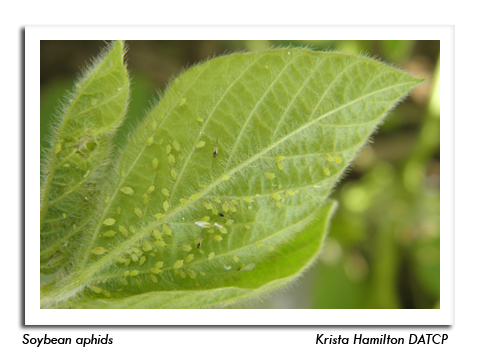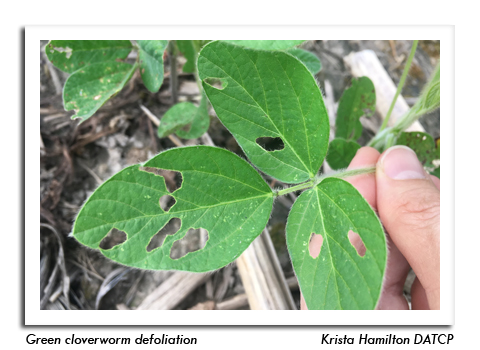
 |
|
|
Soybeans
Volume 62 Number 11 Date 07/13/2017 SOYBEAN APHID - Densities are very low in most fields and moderate at a few sites. None of the 42 soybean fields sampled from July 1-12 had an average count above 30 aphids per plant. However, scattered fields had individual plants with 100 or more aphids concentrated mostly in the field margins, indicating populations are building. As densities escalate, growers and crop advisors are reminded that the aphid treatment threshold established back in 2000 remains valid today, and that insecticide treatment should not be considered until the economic threshold of 250 aphids per plant on 80% of the plants has been exceeded. Aphid counts have not begun to approach this level in any soybean field surveyed by DATCP as of July 12. GREEN CLOVERWORM - Larvae are appearing in southern and western Wisconsin soybean fields. Numbers are still low and defoliation is light (<2% fieldwide), but outbreaks of this caterpillar occur every 5-6 years and conditions are favorable for damaging populations to develop this season. JAPANESE BEETLE - Soybeans across the southern half of the state are showing 2-18% of plants with light to moderate leaf injury by a combination of Japanese beetles, bean leaf beetles, grasshoppers and various caterpillars. Leaf injury by these defoliators should not be allowed to exceed 20% (incidence and severity) between the bloom and pod-fill stages and 30% in the pre-bloom soybeans. The UW-recommended sampling method is to select 10 plants throughout the field, choosing a trifoliate from the upper, middle and lower canopy on each plant, for a 30-leaf sample. Compare the 30 leaflets with an online defoliation estimating guide to determine the average percent defoliation, and if feeding is progressing through the canopy. Scouting several areas in the field interior, in addition to field edges where beetles are most numerous, is required for an accurate assessment. Spot treatment may be considered for severely defoliated border areas. Recall that soybeans can tolerate considerable defoliation without yield loss and defoliation is commonly overestimated. -- Krista Hamilton, DATCP Entomologist 




|
|
|